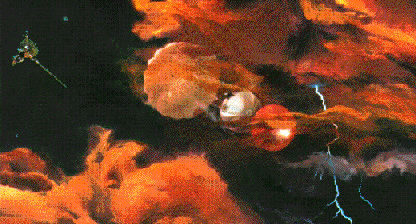
Galileo Probe
NSSDC ID: 1989-084E
Description
The Galileo mission consisted of two spacecraft: an orbiter and a probe. The probe was the first to enter the atmosphere of one of the outer planets.
Released from the orbiter on 13 July 1995 with an arrival of 07 December 1995, the probe had as its scientific objectives to: (1) determine the chemical composition of the Jovian atmosphere; (2) characterize the structure of the atmosphere to a depth of at least 10 bars; (3) investigate the nature of cloud particles and the location and structure of cloud layers; (4) examine the Jovian radiative heat balance; (5) study the nature of Jovian lightning activity; and, (6) measure the flux of energetic charged particles down to the top of the atmosphere. The probe was 1.25 m in diameter and 0.86 m in height. It was comprised of two major segments: a deceleration module and a descent module.
The deceleration module consisted of the fore and aft heat shields and their accompanying support structure and the thermal control hardware for the phases of the mission through entry into the atmosphere. The descent module, which contained the science instruments and the subsystems required to support them, was the package which descended through the atmosphere by parachute.
During entry into the Jovian atmosphere, as the probe was subjected to temperatures near 14000 K, the forward shield was expected to lose around 60% of its 145 Kg mass. A drogue parachute was deployed, using a mortar, when the probe was at a velocity of about Mach 0.9 and a dynamic pressure of 6000 N/sq-m. Once the drogue chute was released, explosive bolts were fired to release the aft cover which in turn pulled out and stripped off the bag containing the main parachute. This entire process was designed to take less than 2 s.
The Galileo descent module differed from the Pioneer Venus Large Probe design, which included a sealed pressure vessel, in that the mass was minimized by venting the module and by protecting individual units as necessary with hermetically sealed housings. These housings were designed to survive to pressures of 20 bars and were tested to 16 bars.
Power to the probe was supplied by a LiSO2 battery with a capacity of about 21 A-hour. Mission requirements were for about 16.3 A-hour. The primary source of energy for pyrotechnic events was a set of four thermal batteries.
The duration of the probe's descent through the Jovian atmosphere was expected to last between 48-75 minutes, with the lower limit determined by the minimum required battery capacity and the upper limit by atmospheric pressure.
Alternate Names
- Galileo
- Jupiter Orbiter Probe
Facts in Brief
Launch Date: 1995-07-13
Launch Vehicle: Shuttle-Inertial Upper Stage
Launch Site: Cape Canaveral, United States
Mass: 335.0 kg
Nominal Power: 580.0 W
Funding Agencies
- NASA-Office of Space Science Applications (United States)
- Deutsche Forschunganstalt fuer Luft- und Raumfahrt (DLR, nee DFVLR) (Federal Republic of Germany)
Discipline
- Planetary Science
Additional Information
- Launch/Orbital information for Galileo Probe
- PDMP information for Galileo Probe
- Telecommunications information for Galileo Probe
Data collections from Galileo Probe
Questions or comments about this spacecraft can be directed to: Dr. Edwin V. Bell, II.
Personnel
| Name | Role | Original Affiliation | |
|---|---|---|---|
| Mr. Donald T. Ketterer | Program Manager | NASA Headquarters | dketterer@sl.ms.ossa.hq.nasa.gov |
| Mr. Benny Chin | Project Manager | NASA Ames Research Center | bchin@mail.arc.nasa.gov |
| Mr. Henry C. Brinton | Program Scientist | NASA Headquarters | |
| Dr. Richard E. Young | Project Scientist | NASA Ames Research Center | reyoung@mail.arc.nasa.gov |
Selected References
Johnson, T. V., et al., Space science reviews volume of Galileo mission overview, Space Sci. Rev., 60, No. 1-4, 3-21, May 1992.
Young, R. E., et al., Galileo Probe: In situ observations of Jupiter's atmosphere, Science, 272, No. 5263, 837-838, May 1996.
Orton, G., et al., Earth-based observations of the Galileo Probe Entry site, Science, 272, No. 5263, 839-840, May 1996.
Other Galileo Information/Data at NSSDC
NSSDC Master Catalog Information
Galileo Orbiter
Galileo Orbiter experiments
Galileo Orbiter data
STS 34 (Galileo deployment mission)
Event Information
Galileo probe timeline of events
Galileo orbiter event information
Images (on-line and on CD-ROM)
Index of images taken by Galileo in the NSSDC Photo Gallery
Galileo Images of Callisto
Galileo Images of Ganymede
Galileo Images of Europa
Galileo Images of Io
Order the Galileo imaging CD-ROM set
JPL Press Releases
Surprising early science results from the Galileo probe
More science results from the Galileo probe
Science results from the first Io flyby!
Science results from the first Ganymede flyby!
Possible discovery of liquid water on Europa
Possible discovery of ionosphere on Io
More about water on Europa
Wet and dry spots on Jupiter
Discovery of ionosphere on Europa
Galileo's tape recorder problem (NASA press release, 10/12/95)
Galileo's fixed tape recorder (NASA press release, 10/21/95)
More about Galileo's tape recorder (NASA press release, 10/26/95)
Related Information/Data at NSSDC
Other Sources of Galileo Orbiter Information/Data
Project
Galileo Project Home Page (NASA JPL)
Education
Online from Jupiter (K-12 student/teacher information/activities)

Galileo Probe
